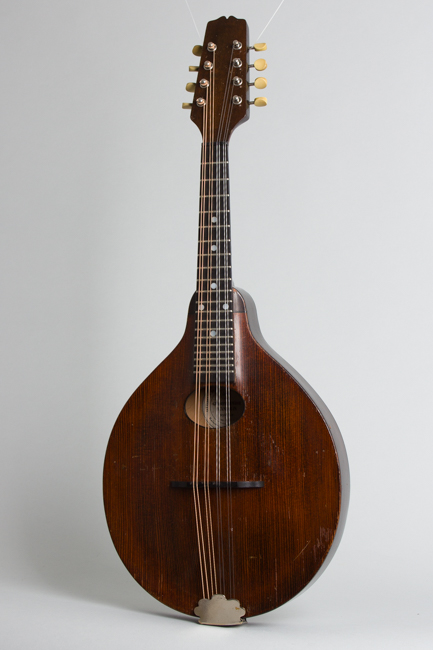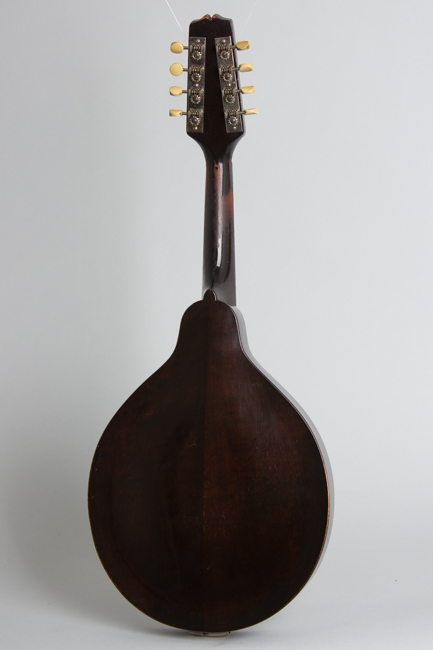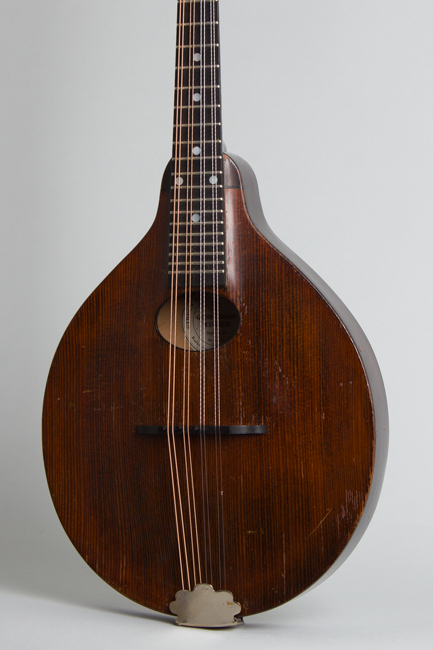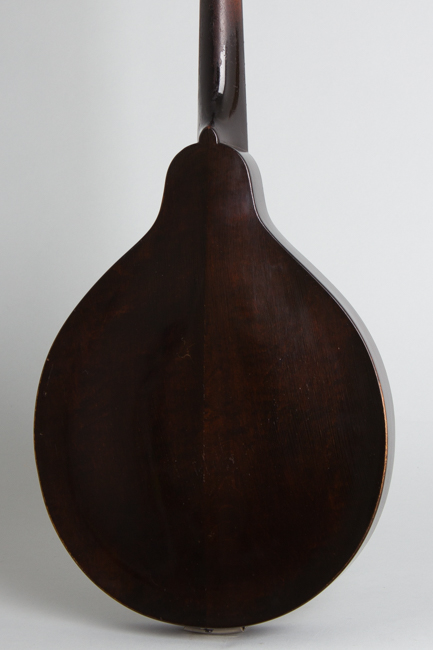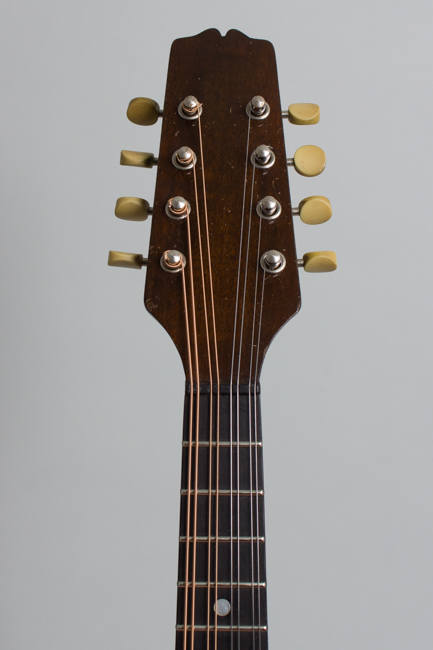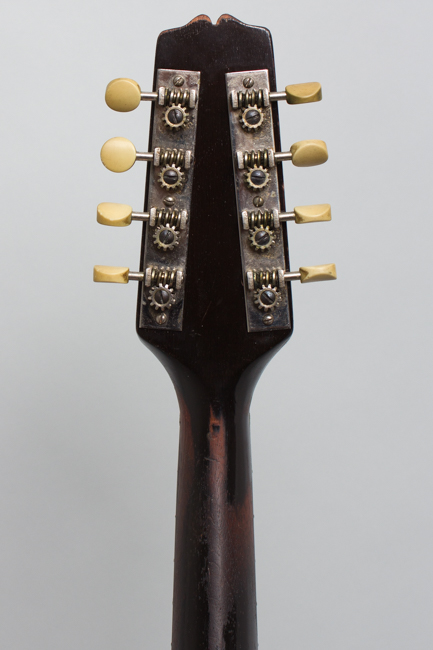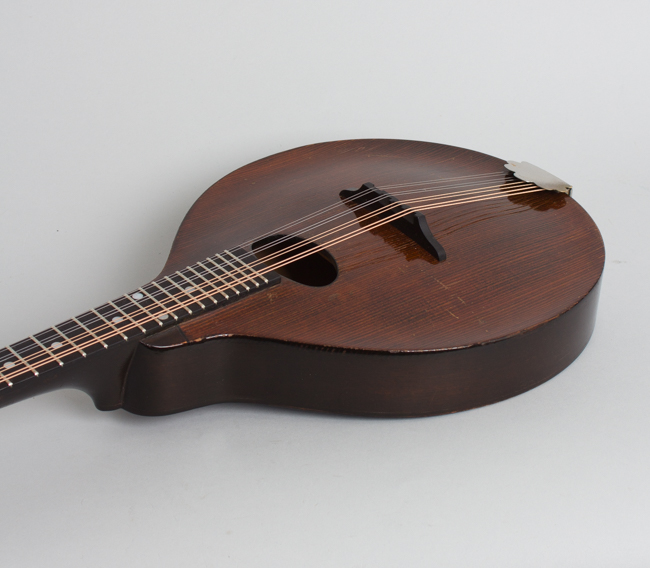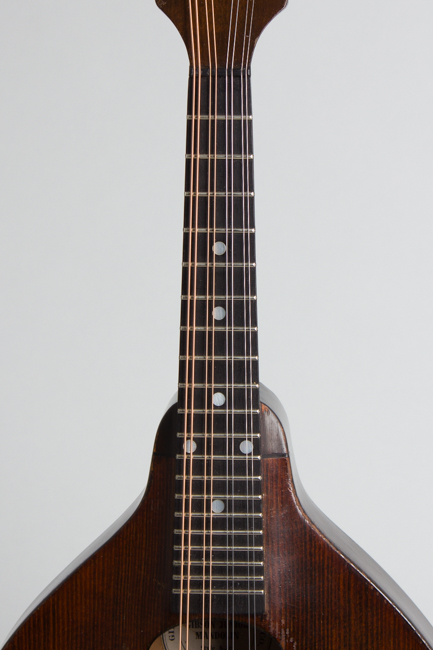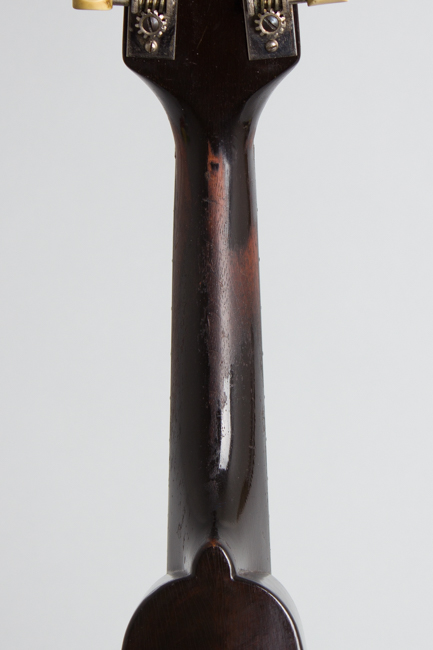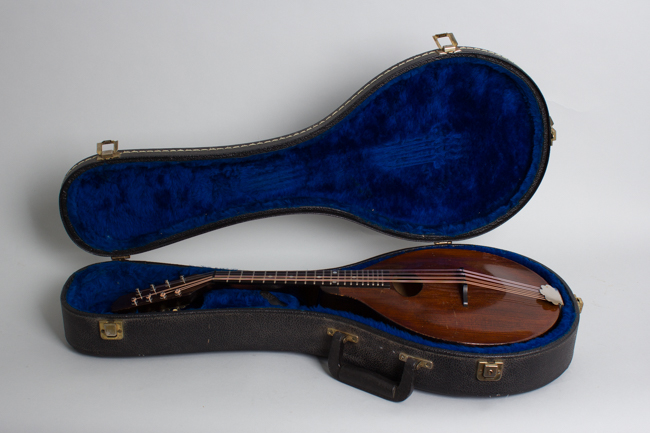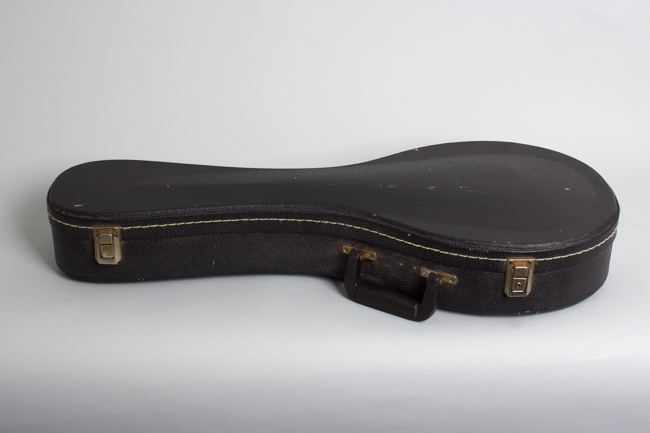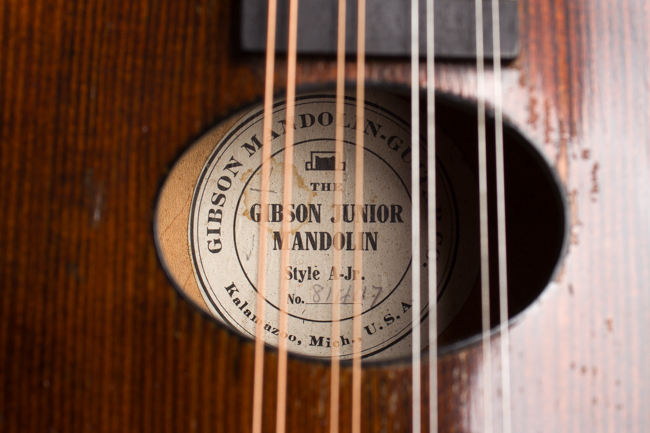Gibson A-Junior Snakehead Carved Top Mandolin (1927)
Gibson A-Junior Snakehead Model Carved Top Mandolin (1927), made in Kalamazoo, Michigan, serial # 81447, brown stain finish, birch back and sides, spruce top; mahogany neck with ebony fingrboard, black tolex hard shell case.
This is a great-playing and sounding original A-Junior mandolin from the later 1920s, built after the "Loar era" came to an end at Gibson but still embodying many of "Master Loar's" ideas. This lovely example of Gibson's mandolin craftsmanship was built in early 1927 (based on the factory order number) while the serial number indicates it was shipped a bit later that year. By this time the company's focus had shifted primarily to banjos, with mandolin sales slowing to a crawl.
"Snakeheads" are generally considered the best-sounding roundhole "A" style mandolins ever made, revered for their unmatched tone and projection compared to earlier or later A-models. They are nicknamed for their Loar-designed peghead that angles inward towards the tip, a superior feature inexplicably abandoned by Gibson not long after this one was made.
The A-Junior was Gibson's lowest priced carved top mandolin in the 1920's, designed primarily for sale to beginning students. The top and back are still fully carved like the higher priced models as the instrument was designed to still sound "Gibsonic" at the lowest price point. To this end it has no ornament at all but is still built to the same standards as the company's higher end instruments.
While this basic A-Junior lacks some of the advanced features of the era (it does not have an adjustable truss rod or height-adjustable bridge) it does sport Loar's slimmer neck profile and sleeker peghead shape. The finish is a clear lacquer coat over an overall brown stain; this is the period when Gibson was moving from varnish to lacquer finishes and the results were sometimes inconsistent. This one is shinier than earlier examples but appears all original.
There is no binding or soundhole rosette at all. The tailpiece has a simple "clamshell" cover plate and the tuners are plain openback strips. Even this most basic "Junior" model is a very fine instrument, with sonic and playing improvements carrying over from "Master Loar's" tenure still evident in the later 1920s, and nearly 100 years on making for a very fine sounding (if plain looking) mandolin.
Overall length is 25 3/4 in. (65.4 cm.), 10 1/4 in. (26 cm.) wide, and 1 7/8 in. (4.8 cm.) in depth, measured at side of rim. Scale length is 14 in. (356 mm.). Width of nut is 1 3/16 in. (30 mm.).
This 98 year old mandolin has seen some use since new, but remains an excellent player with a lively sound. The lacquer-over-varnish finish remains original, still shiny with a decent amount of typical checking to the top and a collection of dings, dents, and scrapes overall, most notable on the top. A few old dings these have been fairly clumsily touched up but this is not overly conspicuous. There is some wear-through to the unbound body edges and the finish is more heavily down to the wood on much of the back of the neck. There are a few spots where the back/side seams have been resealed but no visible cracks.
The hardware remains original including the tuners, bridge and tailpiece; the pickguard is long gone. The neck has remained true for 98 years; it has been neatly refretted with wire slightly larger than the original very narrow spec. This is an nice example of Gibson's plainest 1920s A Model, still cleaner than many and still an sounding instrument nearly a century on. It is housed in a modern HSC...it likely originally came swathed in chipboard. Overall Very Good + Condition.
This is a great-playing and sounding original A-Junior mandolin from the later 1920s, built after the "Loar era" came to an end at Gibson but still embodying many of "Master Loar's" ideas. This lovely example of Gibson's mandolin craftsmanship was built in early 1927 (based on the factory order number) while the serial number indicates it was shipped a bit later that year. By this time the company's focus had shifted primarily to banjos, with mandolin sales slowing to a crawl.
"Snakeheads" are generally considered the best-sounding roundhole "A" style mandolins ever made, revered for their unmatched tone and projection compared to earlier or later A-models. They are nicknamed for their Loar-designed peghead that angles inward towards the tip, a superior feature inexplicably abandoned by Gibson not long after this one was made.
The A-Junior was Gibson's lowest priced carved top mandolin in the 1920's, designed primarily for sale to beginning students. The top and back are still fully carved like the higher priced models as the instrument was designed to still sound "Gibsonic" at the lowest price point. To this end it has no ornament at all but is still built to the same standards as the company's higher end instruments.
While this basic A-Junior lacks some of the advanced features of the era (it does not have an adjustable truss rod or height-adjustable bridge) it does sport Loar's slimmer neck profile and sleeker peghead shape. The finish is a clear lacquer coat over an overall brown stain; this is the period when Gibson was moving from varnish to lacquer finishes and the results were sometimes inconsistent. This one is shinier than earlier examples but appears all original.
There is no binding or soundhole rosette at all. The tailpiece has a simple "clamshell" cover plate and the tuners are plain openback strips. Even this most basic "Junior" model is a very fine instrument, with sonic and playing improvements carrying over from "Master Loar's" tenure still evident in the later 1920s, and nearly 100 years on making for a very fine sounding (if plain looking) mandolin.
Overall length is 25 3/4 in. (65.4 cm.), 10 1/4 in. (26 cm.) wide, and 1 7/8 in. (4.8 cm.) in depth, measured at side of rim. Scale length is 14 in. (356 mm.). Width of nut is 1 3/16 in. (30 mm.).
This 98 year old mandolin has seen some use since new, but remains an excellent player with a lively sound. The lacquer-over-varnish finish remains original, still shiny with a decent amount of typical checking to the top and a collection of dings, dents, and scrapes overall, most notable on the top. A few old dings these have been fairly clumsily touched up but this is not overly conspicuous. There is some wear-through to the unbound body edges and the finish is more heavily down to the wood on much of the back of the neck. There are a few spots where the back/side seams have been resealed but no visible cracks.
The hardware remains original including the tuners, bridge and tailpiece; the pickguard is long gone. The neck has remained true for 98 years; it has been neatly refretted with wire slightly larger than the original very narrow spec. This is an nice example of Gibson's plainest 1920s A Model, still cleaner than many and still an sounding instrument nearly a century on. It is housed in a modern HSC...it likely originally came swathed in chipboard. Overall Very Good + Condition.
